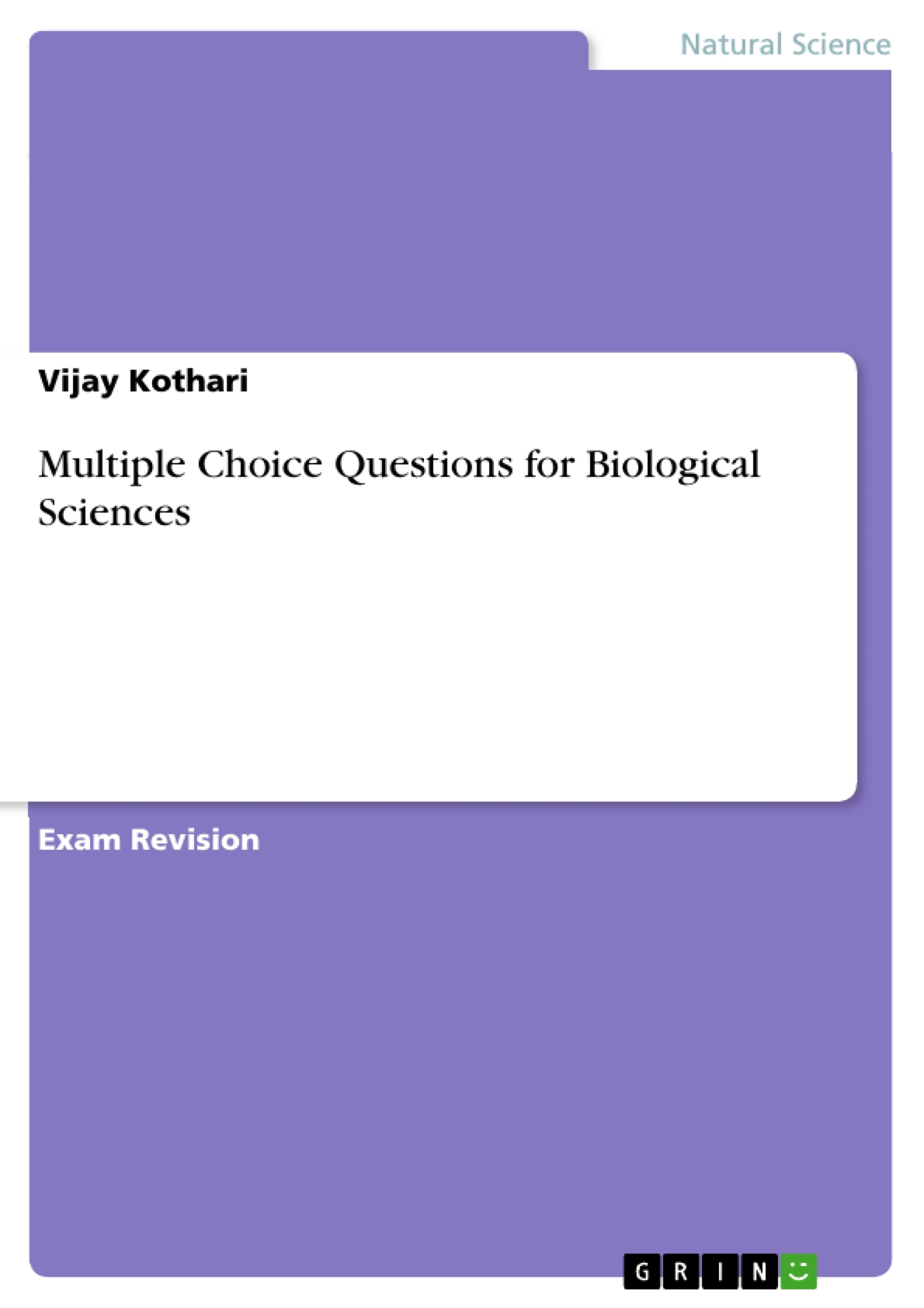This is a compilation of more than 100 multiple choice questions pertaining to different areas of biological sciences. This compilation is intended to be helpful to those who are preparing for appearing in any of the competitive examinations at various levels. Questions mainly are from the fields of Microbiology, Biochemistry, Biotechnology, Immunology, Biomedical Engineering, etc. All correct answers are put in bold face for immediate reference of the reader. Teachers may also find some questions from this compilation suitable for inclusion in various test papers.
This is a compilation of more than 100 multiple choice questions pertaining to different areas of biological sciences. This compilation is intended to be helpful to those who are preparing for appearing in any of the competitive examinations at various levels. Questions mainly are from the fields of Microbiology, Biochemistry, Biotechnology, Immunology, Biomedical Engineering, etc. All correct answers are put in bold face for immediate reference of the reader. Teachers may also find some questions from this compilation suitable for inclusion in various test papers.
(Correct answers are highlighted in bold face)
1. Introns are absent from genome of :
A. Eukaryotes
B. Prokaryotes
C. Both
2. Which of following is a non-polar solvent:
A. Methanol
B. Chloroform
C. Ethanol
Which of the following branches deals with biochemical pathways of plants?
A. Phytochemistry
B. Pharmacognosy
C. Plant Biochemistry
3. The first human disease proved to have a viral cause was_________
A. Smallpox
B. Rabies
C. Hepatitis
D. Yellow fever
4. Dark ground microscopy is used for detection of _________
A. Spirochetes
B. Fungi
C. Chlamydia
D. Virus
5. Bacteria with tuft of flagella at one end are called_________
A. Monotrichate
B. Peritrichate
C. Bipolar
D. Lophotrichate
6. Which of the following statements about endotoxins is false?
A. They are heat stable.
B. Protein-Polysaccharide-lipid complex in nature
C. Action is often enzymatic
D. Is produced by gram-negative bacteria
7. Hapten _______
A. Produces humoral response
B. Binds to carrier to produce its effects
C. Is high molecular weight protein
D. Is the same as epitope
8. Which immunoglobulin can cross the placenta?
A. Ig A
B. Ig G
C. Ig D
D. Ig E
9. Widal test is a type of _______
A. Precipitation reaction
B. Agglutination reaction
C. Complement fixation test
D. Immunofluorescence
10. Diphtheria toxin acts by__________
A. inhibiting acetylcholine release
B. Inhibiting glucose transport
C. Increasing levels of cyclic AMP
D. Inhibiting protein synthesis
11. The virulence of gonococci is due to________
A. Pili
B. Cell membrane
C. Its intracellular location
D. Cytolytic enzymes
12. What differentiates Nocardia from Actinomycetes?
A. Gram stain
B. Modified acid-fast stain
C. Growth on Sabouraud’s medium
D. Animal pathogenicity
13. Segmented RNA is observed in
A. Rabies virus
B. Influenza virus
C. Coxsackie B virus
D. HIV
14. Which of the following conditions is not of endogenous origin?
A. Phycomycosis
B. Aspergillosis
C. Candidiasis
D. Both A and B
15. Which of the following is associated with dandruff?
A. Candida albicans
B. Malassezia furfur
C. Propionibacterium acnes
D. Clostridium botulinum
16. The only deep mycosis common in India is __________
A. Cryptococcosis
B. Coccidiodomycosis
C. Histoplasmosis
D. Blastomycosis
17. Which of the following is not true.
A. Cells in biofilm exhibit greater antibiotic resistance
B. Cells in a biofilm exhibit a slower pace of metabolism and replication
C. Bacterial population inside a biofilm reaches higher cell density than the planktonic forms
D. Biofilms are not involved in human infections.
18. Gene expression profile can be investigated through_________.
A. Genomics
B. Proteomics
C. Metabolomics
D. Transcriptomics
19. Cag pathogenicity island is present in________.
A. Vibrio cholerae
B. Helicobacter pylori
C. Streptococcus mutans
D. Staphylococcus aureus
20. Xanthan gum is obtained from which of the following microbes?
A. Xanthomonas citri
B. Citrobacter spp.
C. Erwinia carotovora
D. Xanthomonas campestris
21. Which of the following mode of microbial communication is likely to be faster, and more effective for less denser populations?
A. Quorum sensing making use of chemical signals
B. Communication using physical signals such as sound
C. Both will happen at almost same speed
D. None of the above
22. Vibrations can be detected by microbes using__________.
a. Mechanosensory channels
b. Cell wall
c. Cell membrane
d. Intracellular fluid
23. Which of the following is a gram-positive bacterium?
a. E. coli
b. S. mutans
c. S. typhi
d. V. cholerae
24. Which of the following is a gram-negative bacterium?
a. S. mutans
b. B. subtilis
c. S. aureus
d. V. cholerae
25. Role of a buffer is to maintain _________.
a. pH
b. Temperature
c. Pressure
d. pH and temperature
[...]
- Citar trabajo
- Ph.D. Vijay Kothari (Autor), 2015, Multiple Choice Questions for Biological Sciences, Múnich, GRIN Verlag, https://www.grin.com/document/305585
-

-

-

-
¡Carge sus propios textos! Gane dinero y un iPhone X. -

-
¡Carge sus propios textos! Gane dinero y un iPhone X. -

-
¡Carge sus propios textos! Gane dinero y un iPhone X. -

-
¡Carge sus propios textos! Gane dinero y un iPhone X. -

-
¡Carge sus propios textos! Gane dinero y un iPhone X. -

-
¡Carge sus propios textos! Gane dinero y un iPhone X. -

-
¡Carge sus propios textos! Gane dinero y un iPhone X.

